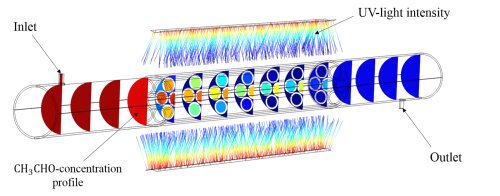In this research we fill the gap between photocatalytic materials and real life application of photocatalysis-based technology for air purification. Several challenges associated with the development, design and upscaling of photocatalytic reactors are tackled through thoughtful combination of experimental design and CFD/Multiphysics modelling.
Designing an efficient photocatalytic reactor for a specific aim presents special challenges based on matching a large number of design parameters: degradation efficiency, photon utilization and light distribution, pressure drop and power consumption, compactness and contact or residence time of contaminants. The operation of a PCO reactor is further complicated since both the mass transfer rate (the advection and diffusion of pollutants to the photocatalytic surface) and the rate of adsorption, desorption and mineralization reactions on the photocatalyst can be limiting factors. To cope with the complexity, we use our computational modelling expertise. Predictive engineering models for airflow and mass transfer (CFD) are combined with models for light irradiation and photocatalytic degradation reaction kinetics. This Multiphysics approach allows us to optimize the removal efficiency of existing photocatalytic reactors but also designing new systems for specific aims and industries.
At our research group, we also combine the described methodology with optimization procedures to assess and test chemical reaction models (which form the basis of reactor engineering) and to estimate the corresponding kinetic parameters for specific photocatalytic surfaces and films. For the latter, experiments with laboratory scale reactors are used.
